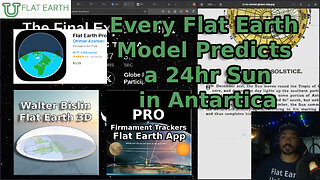Premium Only Content

Flat Earth Math: 24hr Sun in Antarctica
We explore how to predict the 24 hour sun in Antarctica using Flat Earth Science without relying on any globe based models or any astronomical models at all. The concept revolves around understanding solar zeniths and how they correspond to latitude. You can replicate this process at home today, which validates the Scientific Method.
1) Solar Zenith Alignment: The latitude where the sun is directly overhead (the solar zenith) determines where observers will see the sun at its peak. For example, during the December solstice, the sun reaches 23°S declination, aligning with the Tropic of Capricorn.
2) Perspective and Rotation: By recognizing that 1 degree of angular rotation equates to approximately 69 miles on the surface, we can map out how the sun’s apparent motion affects visibility. By adjusting our perspective incrementally, we can visualize the sun’s continuous presence in the Antarctic region.
We leverage this simple geometric framework to predict sunlight conditions, sidestepping assumptions tied to spherical models. With tools like the Firmament Trackers Flat Earth app https://firmamenttrackers.com/pro-version/ we confirm that these predictions align with observed phenomena.
Dive in as we unpack this predictive method and demonstrate how to anticipate the 24-hour Antarctic sun using straightforward math and observations. Let’s challenge the mainstream narrative and explore alternative ways to understand our world!
The Flat Earth Science Textbook is available as a PDF eBook for only $9.99, purchase it today to become empowered with all this knowledge of how the world really works https://store.flatearth.university/product/flat-earth-science-textbook-ebook/
-
 4:40
4:40
Flat Earth University
17 days agoEvery Flat Earth model predicts a 24hr Sun in Antarctica
3343 -
 1:08:16
1:08:16
Tactical Advisor
19 hours agoNEW Budget Glocks | Vault Room Live Stream 011
120K9 -
 16:30
16:30
SNEAKO
1 day agoNO FRIENDS IN THE INDUSTRY.
156K72 -
 6:19
6:19
BlackDiamondGunsandGear
1 day agoHow Fat Guys can Appendix Carry
109K12 -
 6:58
6:58
Gun Owners Of America
1 day ago2024 Was Huge For Gun Rights, Here's Our Top 10 Wins!
87.8K8 -
 15:50
15:50
Degenerate Jay
1 day ago $3.22 earnedJames Bond Is Being Ruined By Amazon? Make Him A Black Gay Woman?
67.2K11 -
 15:18
15:18
DeVory Darkins
1 day ago $27.00 earnedTrump Drops NIGHTMARE Warning on Joe Biden
81.9K118 -
 36:13
36:13
The Why Files
1 month agoAlien Implants Vol. 1: Devil’s Den UFO Encounter: What Was Found Inside Terry Lovelace?
98K40 -
 9:03
9:03
Alabama Arsenal
2 days ago $1.28 earnedAAC HUB 2K | Modern Features, Iconic Classic Looks
29.1K1 -
 13:49
13:49
Dermatologist Dr. Dustin Portela
2 days ago $2.44 earnedDermatologist Reveals the Worst Things To Do To Your Skin
16.5K14